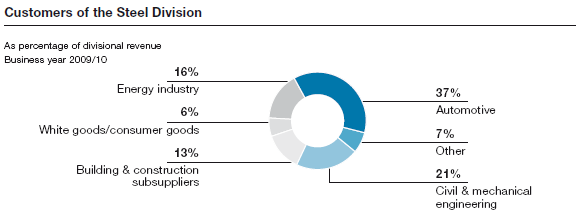The economic environment of the Steel Division in the business year 2009/10, especially during its first months, was very difficult, and the effects of the crisis on the individual business segments were highly variable both with regard to their extent and their time sequence.

In the quality flat steel segment, the “classic” strip products, massive drops in both demand and price that had begun in the fall of 2008 continued throughout the early part of the business year 2009/10 until they bottomed out in the summer of 2009. Subsequently, the market stabilized and, starting in the fall, demand gradually but noticeably began to recover. While the automobile and automotive supply industries saw demand begin to revive and production be stepped up in the second half of the 2009 calendar year, not least due to extensive government stimulus packages (“scrapping premium”), sectors such as the commercial vehicle industry or mechanical engineering faced a far greater collapse of demand (up to 70%), resulting in a recovery that is still much more sluggish than other sectors. An additional favorable factor during 2009 were the historically low inventories and the fact that imports to the EU zone were down compared to previous periods. However, because a number of steel companies accelerated resumption of production in plants that had been temporarily shut down starting in the fall of 2009, the latter months of the year saw significant price pressure in short-term business. However, starting in early 2010, this was followed by a new trend reversal toward significantly higher prices. This development, however, was not primarily due to increased demand on the market, but largely the result of the announcement by the major mine operators that prices for coal and ore would be doubling as of April 1, 2010. With the exception of the scheduled major overhaul of one of the two small blast furnaces (December 2009 to March 2010), all available production capacity was in full operation mode from early September 2009 to the end of the business year 2009/10.
Although the heavy plate segment had a satisfactory order backlog at the beginning of the year, it came under massive pressure in the course of the business year 2009/10. Due to the financial and economic crisis and the downward spiral of oil prices, extensive project shutdowns in the energy sector resulted in major cutbacks in demand and enormous price declines, the latter exacerbated by growing competition from Asia and Russia. It was not until the end of the business year that this segment began to recover, with incoming orders and prices levels increasing. Particularly noteworthy in this regard is growing demand from the wind energy industry, as well as more momentum in oil and natural gas production.

The first half of the 2009/10 year was largely stable in the foundry business segment with good capacity utilization, while the second half of the year was challenging. Incoming orders fell significantly due to weak demand from the energy and mechanical engineering industries, mainly as a result of delays in major steam turbine projects and dwindling demand for gas turbines. On balance, business performance in the hydropower sector continues to be stable at a positive level.
The business year 2009/10 was far more favorable for the Steel Service Center (SSC) than in the other segments of the division; here, demand picked up markedly as early as the summer of 2009, with momentum continuing to trend upward during the quarter. Business performance in the division’s preprocessing activities was significantly less positive, but, similarly to the heavy plate segment, the situation eased up substantially in the course of the final quarter of the business year.
The concept phase for the divisional project “Zukunft” (“Future”) was concluded at the end of the business year 2009/10. In addition to leadership in technology and quality, this project will also ensure cost leadership in key product segments by generating savings of at least EUR 350 million by the business year 2012/13. In addition to pure cost savings, the project is targeted on an even more consistent and optimized control system at division level, the main task of which is to safeguard the organization’s ability to adapt immediately to future market volatility which is continuing to rise.


